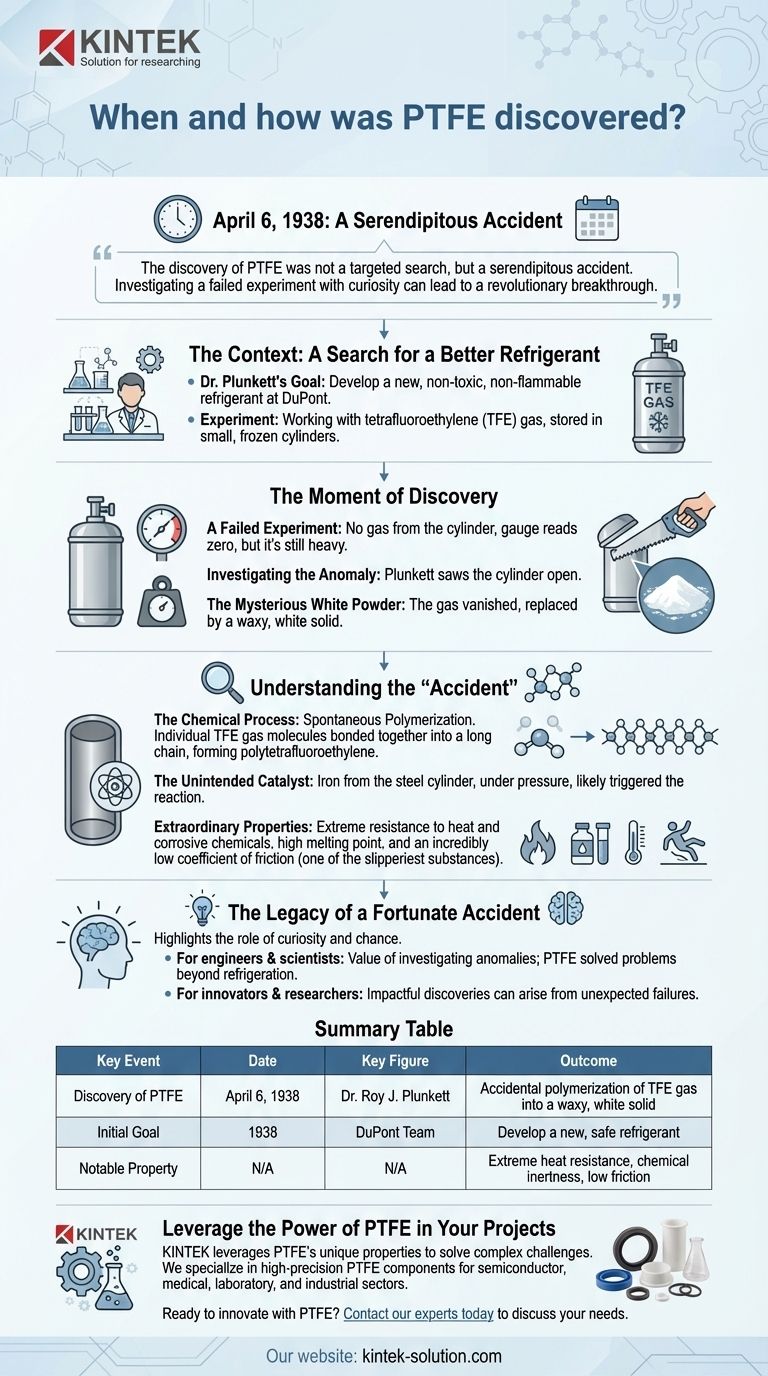On April 6, 1938, the material Polytetrafluoroethylene (PTFE) was discovered entirely by accident. Dr. Roy J. Plunkett, a chemist at DuPont, was researching new refrigerants when he noticed a cylinder of tetrafluoroethylene gas appeared to be empty, yet its weight indicated it was still full. Upon investigating, he discovered the gas had unexpectedly transformed into a mysterious waxy, white solid with remarkable properties.
The discovery of PTFE was not the result of a targeted search for a non-stick material, but a serendipitous accident. It serves as a classic example of how investigating a failed experiment with curiosity can lead to a revolutionary scientific breakthrough.

The Context: A Search for a Better Refrigerant
Dr. Plunkett's Primary Goal
Dr. Plunkett and his team at DuPont's laboratory in New Jersey were not attempting to create a new polymer. Their objective was to develop a new, non-toxic, and non-flammable refrigerant.
The Experiment's Setup
The experiment involved working with a gas called tetrafluoroethylene (TFE). Plunkett had produced a significant amount of TFE gas, which he stored in small cylinders and froze to prepare for the next stage of his refrigerant research.
The Moment of Discovery
A Failed Experiment
When Plunkett prepared to use one of the TFE cylinders, he found that no gas would come out. The pressure gauge read zero, suggesting the bottle was empty, but the cylinder's weight was far too heavy for that to be true.
Investigating the Anomaly
Instead of discarding the cylinder, Plunkett and his assistant decided to find out what had happened. After failing to clear the valve, they eventually sawed the cylinder open to investigate the interior.
The Mysterious White Powder
Inside, they did not find the gas they expected. Instead, the cylinder was coated with a waxy, white powder that was exceptionally slippery to the touch. The TFE gas had vanished, replaced by this new substance.
Understanding the "Accident"
The Chemical Process: Spontaneous Polymerization
Plunkett correctly deduced that the individual TFE gas molecules had bonded together in a long chain, a process known as polymerization. This spontaneous reaction transformed the gas into a new solid: polytetrafluoroethylene.
The Unintended Catalyst
The reaction was likely aided by an unintended catalyst. It is believed that the iron from the inside of the steel cylinder, under high pressure, triggered the polymerization of the TFE gas.
Extraordinary Properties
Initial tests on the new material revealed its unique and valuable characteristics. It was found to be extremely resistant to heat and corrosive chemicals, had a very high melting point, and possessed an incredibly low coefficient of friction, making it one of the slipperiest substances known.
The Legacy of a Fortunate Accident
The discovery of PTFE highlights the role of curiosity and chance in scientific advancement.
- For engineers and material scientists: This story underscores the value of investigating anomalies, as PTFE's unique properties solved problems far beyond the original goal of refrigeration.
- For innovators and researchers: Plunkett's experience is a powerful reminder that the most impactful discoveries can arise from unexpected failures or deviations from a plan.
The accidental creation of PTFE is a powerful reminder that curiosity in the face of the unexpected is the true engine of scientific breakthrough.
Summary Table:
| Key Event | Date | Key Figure | Outcome |
|---|---|---|---|
| Discovery of PTFE | April 6, 1938 | Dr. Roy J. Plunkett | Accidental polymerization of TFE gas into a waxy, white solid |
| Initial Goal | 1938 | DuPont Team | Develop a new, safe refrigerant |
| Notable Property | N/A | N/A | Extreme heat resistance, chemical inertness, and low friction |
Leverage the Power of PTFE in Your Projects
Just as Dr. Plunkett's curiosity led to a revolutionary material, KINTEK leverages PTFE's unique properties to solve complex challenges. We specialize in manufacturing high-precision PTFE components—including seals, liners, and custom labware—for the semiconductor, medical, laboratory, and industrial sectors. Whether you need prototypes or high-volume orders, our custom fabrication ensures reliability and performance.
Ready to innovate with PTFE? Contact our experts today to discuss your specific needs and discover how our solutions can enhance your applications.
Visual Guide

Related Products
- Custom PTFE Parts Manufacturer for Teflon Parts and PTFE Tweezers
- Custom PTFE Parts Manufacturer for Teflon Containers and Components
- Custom PTFE Measuring Cylinders for Advanced Scientific and Industrial Applications
- Custom PTFE Square Trays for Industrial and Laboratory Use
- PTFE Chemical Solvent Sampling Spoon
People Also Ask
- What industrial benefits do PTFE-machined parts offer? Achieve Peak Performance in Demanding Applications
- What chemical processing applications involve PTFE-machined parts? Essential Components for Corrosive & High-Purity Systems
- What are the unique properties of PTFE? The 3 Pillars Driving Demand for High-Performance Parts
- What fabrication services are available for PTFE? Shearing, Stamping, Laser Cutting, Molding & Machining
- What factors should be considered when choosing between Nylon and PTFE? Select the Right Material for Your Application



















